Pyramids ... and more
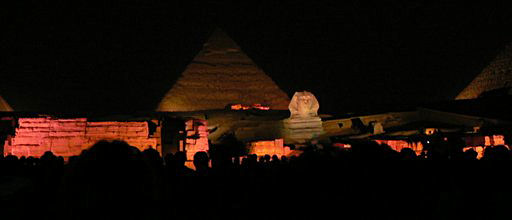
The pyramids and the Sphinx during the "son et
lumière" show
The history of pyramids, indeed, the history of stone
monuments in general, begins with the step pyramid of Djoser
at Saqqara, built by the architect Imhotep about
-2650. The pyramid is part of a funerary complex which one
reaches by first walking through a beautiful hypostyle hall (supported
by columns). According to our guide, Nahla, the idea was new
and the architect, not trusting the columns to support the
roof, erected superfluous walls for this purpose.
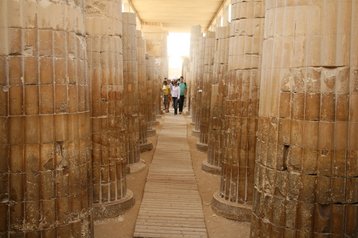 |
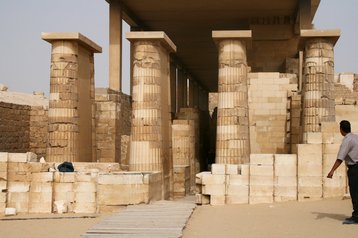 |
| Saqqara,
hypostyle hall |
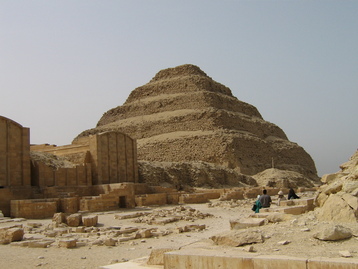 |
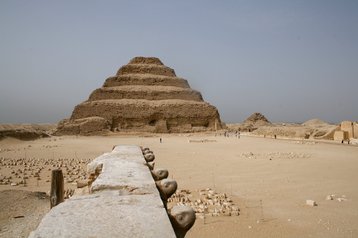 |
| Djoser's step pyramid |
Step pyramid and
wall of cobras |
In fact, the pyramid is a series of mastabas, or funerary chapels in
the form of banks (mastaba,
in arab), each one built on top of the preceding one.
Thus was built the first pyramid.
After Saqqara, other architects tried to build "real"
pyramids, with smooth surfaces, with greater or lesser
success. The largest one built before those of Giza, two of which are larger, is the red pyramid at
Dahshur, which we did not visit. After that, the construction
of other pyramids was transferred to Giza.
The largest pyramid in Egypt and the only one of the Seven
Wonders of the Ancient World which still survives is the Great Pyramid
of Cheops (or Khufu) at Giza. Giza is a strange place, on a desert
plateau dominating the modern city of Cairo. It's like a
desert surrounded by a city. The day of our visit (in
fact, most of our days in Egypt), there was a mist which at first hid
all but the outline of the pyramids as seen from the viewpoint where
the bus stopped "to take some pictures". Mark Twain saw something
similar, as he wrote in The
Innocents Abroad:
At
the
distance of a few miles the Pyramids rising above the palms, looked
very clean-cut, very grand and imposing, and very soft and filmy, as
well. They swam in a rich haze that took from them all suggestions of
unfeeling stone, and made them seem only the airy nothings of a dream--
structures which might blossom into tiers of vague arches, or ornate
colonnades, may be, and change and change again, into all graceful
forms of architecture, while we looked, and then melt deliciously away
and blend with the tremulous atmosphere.
But as we approached the monuments, the sun broke through some and the
stones took on a luminous color. In any case, it was a real thrill to be right there in front
of these mythical monuments!
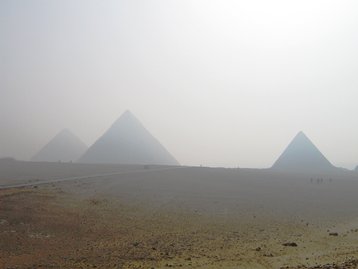 |
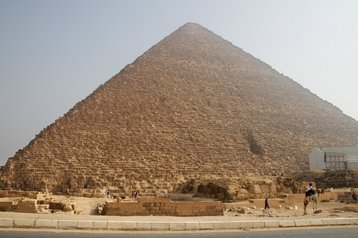 |
| Pyramids in the mist |
The Great Pyramid of
Cheops |
 |
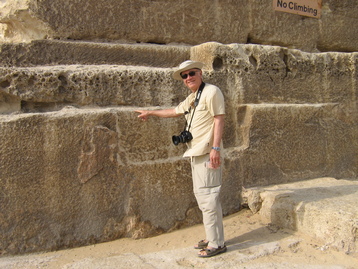 |
| Siv being
photographed/ripped off, duly equipped with turban and
cane. |
John, don't climb
on the pyramid of Chephren (Khafre) |
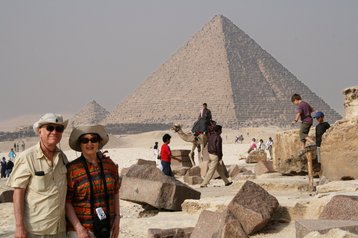 |
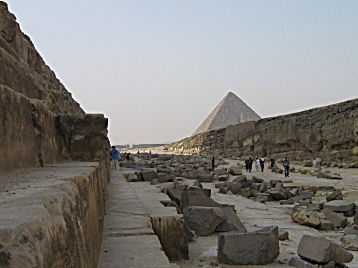
|
| Tourists in front
of the pyramid of Menkaure |
Walk around the
pyramid of Chephren. In the back, the pyramid of Menkaure |
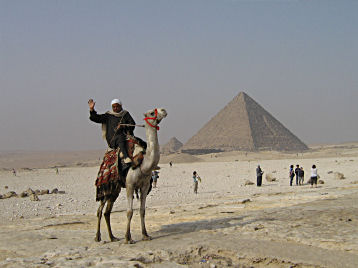 |
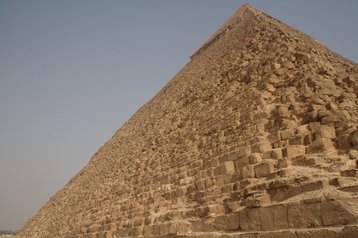 |
| Dromadary and native
with the pyramid of Menkaure |
The stones of the
pyramid of Chephren |
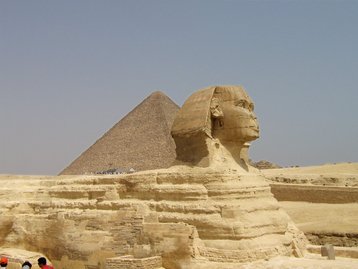 |
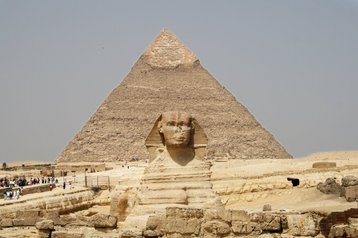 |
The Sphinx of Giza
and the pyramid of Cheops
|
The Sphinx and the
pyramid of Chephren |
Everywhere, one is hassled by "natives" who want to take your picture
or have you take theirs in exchange for baksheesh. They can be
quite charming while they're at it.
Access to the famous Sphinx, about 300 meters from the pyramid of
Cheops, is worse than bizarre. The place where tourists may stand to
view the monument is very small, which increases the density of people. Worse yet, access to the viewpoint is via a narrow
staircase only wide enough to allow two or three people abreast. Traffic
jam
guaranteed. Flaubert, who visited Giza during his Voyage
en Egypte, wouldn't have recognized it. In any case,
we shared at least some of his emotion.
Close to three
thirty we are almost touching the desert where the three pyramids
stand -- I can wait no longer and start my horse galloping and slipping
in the marsh. Maxime [Ducamp], two minutes afterwards, imitates me
-- furious race -- I can't help yelling -- we climb in a cyclone up to
the
Sphinx. At first our Arabs followed us, yelling ... -- He loomed
larger, larger, rose up from the earth like a dog standing up.
Abou-el-Houl ["the father of terror", the arab name for the
Sphinx]
-- sand, pyramids, the Sphinx, everything is grey and drowned in a
great pink color -- the sky is all blue -- eagles turn and glide slowly
around the peak of the pyramids -- we stop in front of the Sphinx -- it
looks at us in a terrifying way. Maxime is quite pale. I am afraid I'm
getting dizzy, and I try to control my emotion.
We start out again at full speed, madmen, carried away in the middle of
the stones. We ride all around the pyramids right at their base,
slowly. Our luggage is late coming -- night falls.
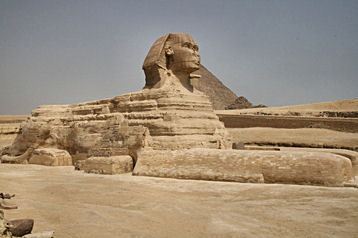

Return
to the introduction.


















